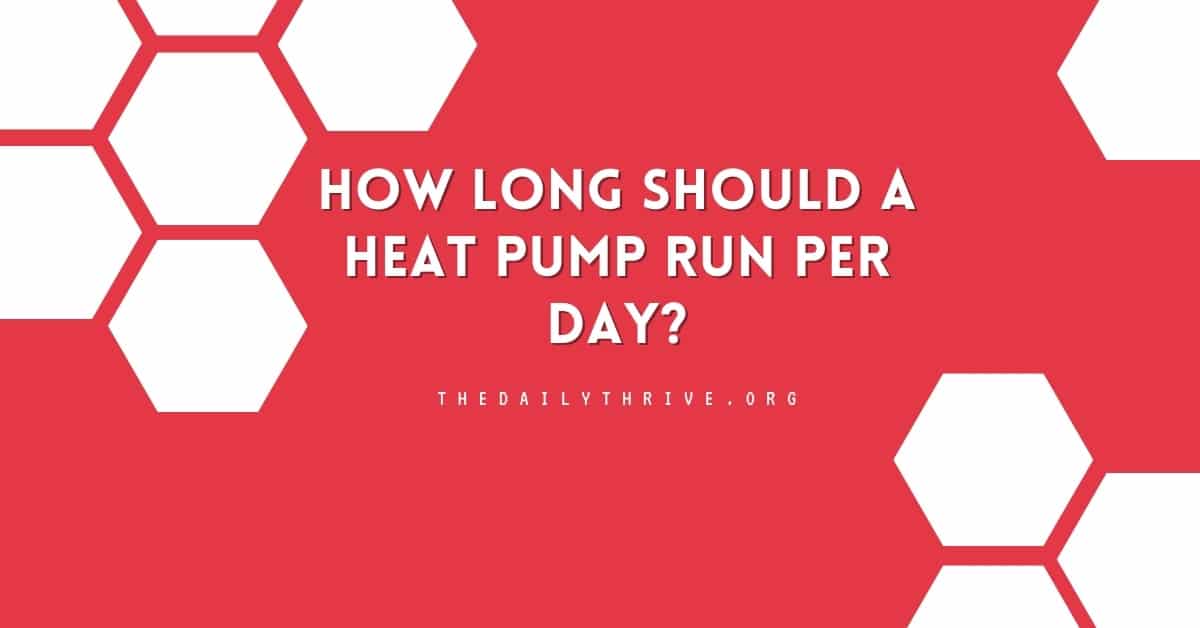In the quest for a comfortable, energy-efficient home, heat pumps are a versatile solution, adept at heating and cooling. However, homeowners often ponder over the optimal runtime for these systems. How long should a heat pump run each day? What factors influence this duration? And, importantly, when does the operation of a heat pump signify efficiency, and when does it point to a potential issue?
The daily runtime of a heat pump can vary significantly based on external temperatures and your specific home’s needs. Generally, during milder seasons like spring and fall, a heat pump may run 6 to 8 hours daily. In colder winter months, especially when temperatures drop to around 30 degrees Fahrenheit or lower, it’s common and often necessary for a heat pump to run continuously throughout the day.
This article unpacks the complexities surrounding heat pump runtimes, offering comprehensive insights to ensure your system operates effectively, ensuring comfort while conserving energy.
Daily Operation Hours of a Heat Pump
The operation time of a heat pump varies significantly with the season and external temperature conditions. During transitional seasons like fall and spring, a heat pump typically operates for about 6 to 8 hours a day. This duration adjusts based on the internal and external temperature of your home.
However, heat pumps shoulder a heavier load during winter. When temperatures hover around 30 degrees Fahrenheit, a heat pump’s operation time escalates, potentially running continuously throughout the day. This extended operation ensures your home remains warm and comfortable even during the coldest months.
Cycling Frequency of Heat Pumps
Understanding the cycling frequency of your heat pump is crucial for optimizing its efficiency.
A ‘cycle’ in heat pump terminology refers to the complete process of absorbing external heat and then releasing it indoors. The cycling frequency is influenced by factors such as the ambient temperature and the thermostat settings.
A typical heat pump cycles about 2 to 3 times per hour. This means that in 24 hours during winter, you might observe anywhere from 48 to 72 cycles. Each cycle lasts about 10-20 minutes, ensuring the indoor temperature is consistently maintained according to your preferences.
Should Heat Pumps Run Continuously?
Heat pumps are common and expected to operate continuously in winter. When the outside temperature drops below 30 to 40 degrees Fahrenheit, the heat pump must work relentlessly to draw in sufficient heat to keep your home warm.
Is it normal for my heat pump to run continuously?
Yes, it’s normal for a heat pump to run continuously during extremely cold weather. Heat pumps are designed to maintain a consistent temperature inside your home. When it’s particularly cold outside, they need to work harder and may run without stopping to keep up.
However, if you notice that your heat pump is running nonstop during warmer seasons like summer or during milder periods of spring and fall, this could indicate an underlying issue. Continuous operation in such conditions might signal inefficiencies or faults within the system that require professional assessment and intervention.
Maximizing Heat Pump Performance
Ensuring your heat pump runs like a well-oiled machine involves more than passive observation.
Here are some proactive steps to keep it at its efficient best:
- Monitor Cycles: Monitor your heat pump’s cycling pattern. An uptick in frequency or an unusual increase in operation duration outside cold months merits attention. It could be a symptom of an underlying issue begging for a fix.
- Regular Maintenance: Like any stalwart companion, your heat pump deserves regular check-ups. Keeping the filters pristine, ensuring the coils and fans are devoid of debris, and having a professional give it the once-over can go a long way in maintaining its health and efficiency.
- Thermostat Settings: The thermostat isn’t just a dial or a set of buttons — it’s your command center. Setting it to a reasonable, energy-efficient temperature is key. Hyper cooling or heating strains your heat pump and wallet, resulting in inflated energy bills.
Understanding how long and how often your heat pump should run per day is crucial in harmonizing comfort with energy efficiency. As seasons change and temperatures swing, your heat pump adapts, ensuring your home remains an oasis of comfort. Observing its operation, proactive maintenance and reasonable thermostat management can keep your heat pump humming smoothly, making every day in your home a testament to cozy, efficient living.






